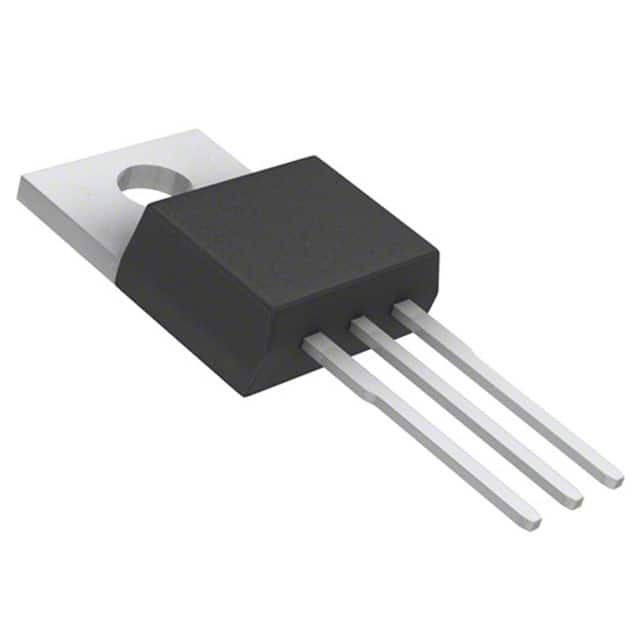RFP2N10L: Product Overview and Specifications
Introduction
RFP2N10L is a power MOSFET belonging to the category of electronic components. It is widely used in various electronic circuits and applications due to its unique characteristics and performance.
Basic Information Overview
- Category: Power MOSFET
- Use: RFP2N10L is commonly used as a switching device in electronic circuits, particularly in power supply and motor control applications.
- Characteristics: The MOSFET features low on-state resistance, high switching speed, and low gate drive power. These characteristics make it suitable for high-efficiency power conversion applications.
- Package: RFP2N10L is typically available in TO-220 packaging, which provides thermal efficiency and ease of mounting.
- Essence: The essence of RFP2N10L lies in its ability to efficiently control high-power loads with minimal losses.
- Packaging/Quantity: It is usually supplied in reels or tubes containing multiple units, depending on the manufacturer's specifications.
Specifications
- Drain-Source Voltage (VDS): 100V
- Continuous Drain Current (ID): 2A
- On-State Resistance (RDS(on)): 1.2Ω
- Gate-Source Voltage (VGS): ±20V
- Operating Temperature Range: -55°C to 150°C
Detailed Pin Configuration
The pin configuration of RFP2N10L typically consists of three pins: 1. Gate (G): Input pin for controlling the switching operation. 2. Drain (D): Output pin connected to the load. 3. Source (S): Common pin and reference point for the source of the MOSFET.
Functional Features
- High Efficiency: RFP2N10L offers high efficiency in power conversion due to its low on-state resistance and fast switching characteristics.
- Reliability: The MOSFET is designed for reliable operation under varying load conditions and temperatures.
- Low Gate Drive Power: It requires minimal power to drive the gate, reducing overall power losses in the system.
Advantages and Disadvantages
Advantages
- High efficiency in power conversion
- Fast switching speed
- Low gate drive power requirement
Disadvantages
- Limited maximum drain-source voltage compared to some other power MOSFETs
- Relatively low continuous drain current rating
Working Principles
RFP2N10L operates based on the principles of field-effect transistors. When a sufficient voltage is applied to the gate terminal, it creates an electric field that allows current to flow between the drain and source terminals, effectively controlling the power flow through the MOSFET.
Detailed Application Field Plans
RFP2N10L finds extensive use in the following application fields: - Switching Power Supplies: It is utilized in various types of power supplies to regulate and control the flow of power. - Motor Control: RFP2N10L is employed in motor control circuits to manage the speed and direction of motors efficiently. - Inverters: It plays a crucial role in inverter circuits for converting DC power to AC power in applications such as solar inverters and UPS systems.
Detailed and Complete Alternative Models
Some alternative models to RFP2N10L include: - IRF540N - FQP30N06L - STP55NF06L - IRLB8748
In conclusion, RFP2N10L is a versatile power MOSFET with distinct characteristics that make it suitable for a wide range of electronic applications, especially those requiring efficient power management and control.
Word count: 511
Senaraikan 10 soalan dan jawapan biasa yang berkaitan dengan aplikasi RFP2N10L dalam penyelesaian teknikal
What is RFP2N10L?
- RFP2N10L is a power MOSFET transistor designed for use in various electronic applications, including power supplies, motor control, and lighting.
What are the key specifications of RFP2N10L?
- The RFP2N10L has a maximum drain-source voltage of 100V, a continuous drain current of 2A, and a low on-resistance for efficient power handling.
How can RFP2N10L be used in power supply designs?
- RFP2N10L can be utilized in power supply designs to switch high currents with minimal power loss, making it suitable for efficient and compact power supply solutions.
In what types of motor control applications can RFP2N10L be employed?
- RFP2N10L can be used in motor control applications such as brushed DC motor drives and small brushless DC motor controllers due to its ability to handle moderate current levels.
What are the thermal considerations when using RFP2N10L in technical solutions?
- Proper heat sinking and thermal management are essential when using RFP2N10L to ensure that it operates within its specified temperature limits and maintains reliability.
Can RFP2N10L be used in LED lighting applications?
- Yes, RFP2N10L can be employed in LED lighting applications to drive and control LED arrays or modules, providing efficient power switching for lighting systems.
Are there any specific circuit design considerations when integrating RFP2N10L into technical solutions?
- Designers should consider gate drive requirements, voltage and current ratings, and protection circuitry to ensure optimal performance and reliability in their applications.
What are the advantages of using RFP2N10L in technical solutions compared to other components?
- RFP2N10L offers low on-resistance, high current capability, and fast switching characteristics, making it suitable for high-efficiency and compact designs.
What are the typical operating conditions for RFP2N10L in technical solutions?
- RFP2N10L is typically operated within specified voltage, current, and temperature ranges, and its performance can be optimized by adhering to these conditions.
Where can I find application notes or reference designs for using RFP2N10L in technical solutions?
- Application notes and reference designs for RFP2N10L can often be found on the manufacturer's website or through technical literature related to power electronics and semiconductor devices.


